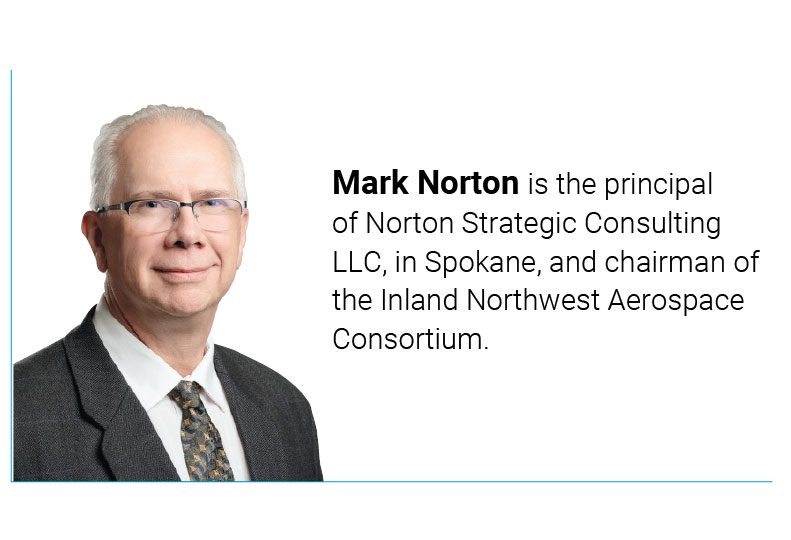
Home » Washington state leads charge in aerospace advances
Washington state leads charge in aerospace advances
Aerospace, electric transportation, robotic innovations at hand

April 7, 2022
It’s a beautiful spring morning in the Inland Northwest. The year is 2030.
As your morning alarms goes off, and you get out of bed, your smart device announces that you have a prescription delivery. Just a few hours earlier, while you were sleeping, a drone device deposited your latest medicines in the secure lockbox on your front porch.
And as you proceed to get ready for a flight later in the day, you receive a text message that your air taxi will be arriving in front of your house that day. Soon, it will be whisking you over rush-hour traffic and dropping you off directly at the terminal.
From there, robots that are enhanced by AI will take care of your luggage, and smart facial recognition software will check you in for your flight. Within a few minutes, you are flying a small, electric-powered commuter aircraft to a regional hub, just a short distance from your first appointment.
A fantasy? Not at all. Transportation of the future will use all these technologies and more. And Washington state is leading the charge.
Two years ago, the onset of COVID created some significant headwinds for Washington’s Boeing-centric supply chain. That event, combined with tragic crashes and subsequent grounding of Boeing Co.’s MAX aircraft, created a “black swan” scenario for Boeing’s vendors throughout the state. Revenues within the supplier framework dropped anywhere from 30% to 80% within just a few months, depending on the company and the Boeing programs that they supported.
But the second quarter of 2021 started a tremendous resurgence in demand for commercial aircraft, as leisure and business travel resumed. At the same time, we saw companies like MagniX USA Inc. and Eviation Aircraft Inc. start the first test flights of electric-powered aircraft in the Puget Sound and Moses Lake areas. And the emerging space-satellite sector saw job growth of over 200% over the next 12 months in the Greater Seattle area.
Additionally, Puget Sound began an accelerating evolution as a major incubator for drone technology, industry 4.0, cobot (coworker robot) innovation, and many other supporting technologies for aerospace manufacturing. Even in our region, commercial space companies like Space X and Blue Origin became increasingly engaged with local manufacturing entities.
Our state’s leaders have recognized that aerospace will continue to be a major economic engine for Washington. As a result, an aerospace and aviation committee has been created to make policy and funding recommendations to the Washington state Legislature.
This is a project of major scope, not only looking at core advanced manufacturing sectors, but including the support systems around workforce/education, hard infrastructure at airports, equity, and more. Director Lisa Brown from the Washington state Department of Commerce, and Secretary Roger Millar from the state Department of Transportation, will lead the committee, which has 30 members from industry, education, and government.
One of the primary goals of the committee will be to make sure the economic impact of our efforts will reach beyond Puget Sound, to rural communities and Eastern Washington.
In Spokane, that effort is already underway, supported by the collaborative efforts of the Inland Northwest Aerospace Consortium, Greater Spokane Incorporated, Spokane International Airport, S3R3 Solutions, the Evergreen Bioscience innovation cluster, and others. The collective vision is to position Spokane as the next major industry hub for aerospace, space, and biomedical devices. The economic impact of these industries for Spokane’s workforce cuts across multiple demographics, from degreed technical positions to the skilled trades.
And Eastern Washington has a strong value proposition when it comes to companies looking for closer proximity to the Interstate 5-Boeing ecosystem. Despite the recent housing pricing boom in our region, we still offer a lower cost of living compared to the I-5 corridor, and a quality of life that offers relief from the traffic congestion of the metro areas on the west side of the state. We have a pipeline of engineering resources at Washington State University, Eastern Washington University, University of Idaho, and Gonzaga. And with air service, freight hubs, and rail service, we have a logistics infrastructure that provides overnight delivery to the Puget Sound.
There are still some challenges to overcome. And perhaps the biggest hurdle for the aerospace industry, as with most other sectors in our economy, remains the constrained availability of new workers. Many baby boomers took early retirement over the last few years, and that “silver tsunami” has accelerated an exodus of skilled trades from our workforce. Solving that problem will require a multidisciplinary approach.
The next few decades offer a once-in-a-generation opportunity to leverage new technology for the environmental and economic benefit of our region. Working together—which is our strength—we can seize this opportunity for the benefit of everyone.
Like this story?
You’ll love the rest. Subscribe today, and you’ll receive a year’s subscription to the Journal of Business, unlimited access to this website, daily business news emails, and weekly industry-specific
e-newsletters. Click here for 50% off your first year.
Latest News Technology
Related Articles
Related Products




